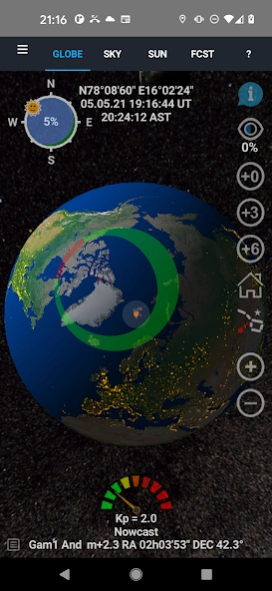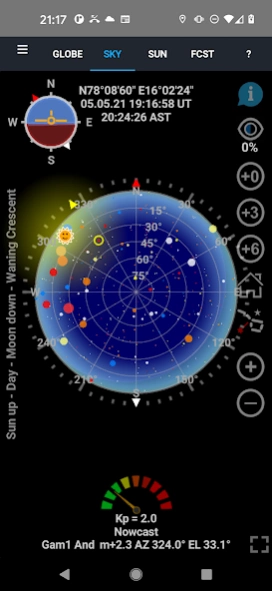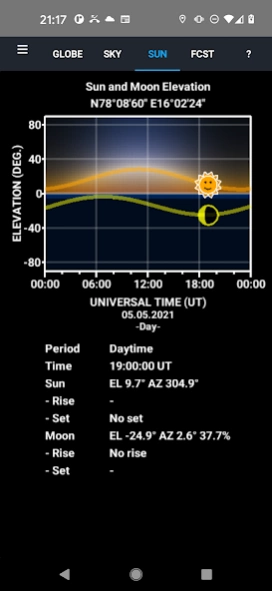Aurora Forecast 3D 8.6
Free Version
Publisher Description
Aurora Forecast 3D - The app forecasts the location of the auroral oval up +3 days in time.
The Aurora Forecast 3D is a tool to track down where the aurora is located in the sky from any location on planet. It renders Earth in 3D with rotation and scaling at your fingertips. You can select locations and make your own ground - station list. The Sun illuminates the globe as it updates in near real-time. The short term forecasts are up to +6 hours, while the long term forecasts are up to 3 days ahead in time. They are updated when the app is active and connected to internet.
An Aurora Compass is included that shows where the auroral oval [1,2], the Moon and the Sun are located as you look up at the sky from your location. The phase and age of the Moon is also visualized in the compass. By zooming out in the 3D view port, satellites, stars and planets appear in their orbits [3] around the Sun.
FEATURES
- 3D view port of Earth.
- Solar illumination of the Earth and the Moon.
- Aurora oval size and location in real time.
- Day side location of the red Cusp.
- Forecasts based on predicted Kp index estimated by the Space Weather Prediction Centre (NOAA-SWPC).
- Includes a 2.4 million star map [4].
- City light texture [5].
- Earth, Sun and Moon textures [6,7].
- Sky view module to track planets and stars [8].
- 3-day space weather condition forecast as news ticker.
- Two-Line Element (TLE) satellite orbit calculations [9].
- Skyview navigation.
- 3D Laser Star pointer to identify star signs.
- Sounding rocket trajectories.
- Sun and Moon daily elevation plots with rise and set time.
- Epoch selection for magnetic pole position [10]
- Ovals based on polar orbiting satellites data [11]
- Target web links added to satellites, stars, planets and position.
- All-sky camera links to the Boreal Aurora Camera Constellation (BACC).
- Sky color animation [12,13].
- Zhang and Paxton ovals added [14]
- Geomagnetic storm push notifications.
- Youtube demonstration.
References
[1] Sigernes F., M. Dyrland, P. Brekke, S. Chernouss, D.A. Lorentzen, K. Oksavik, and C.S. Deehr, Two methods to forecast auroral displays, Journal of Space Weather and Space Climate (SWSC), Vol. 1, No. 1, A03, DOI:10.1051/swsc/2011003, 2011.
[2] Starkov G. V., Mathematical model of the auroral boundaries, Geomagnetism and Aeronomy, 34 (3), 331-336, 1994.
[3] P. Schlyter, How to compute planetary positions, http://stjarnhimlen.se/, Stockholm, Sweden.
[4] Bridgman, T. and Wright, E., The Tycho Catalog Sky map- Version 2.0, NASA/Goddard Space Flight Center Scientific Visualization Studio, http://svs.gsfc.nasa.gov/3572, January 26, 2009.
[5] The Visible Earth catalog, http://visibleearth.nasa.gov/, NASA/Goddard Space Flight Center, April-October, 2012.
[6] T. Patterson, Natural Earth III - Texture Maps, http://www.shadedrelief.com, October 1, 2016.
[7] Nexus - Planet Textures, http://www.solarsystemscope.com/nexus/, January 4, 2013.
[8] Hoffleit, D. and Warren, Jr., W.H., The Bright Star Catalog, 5th Revised Edition (Preliminary Version), Astronomical Data Center, NSSDC/ADC, 1991.
[9] Vallado, David A., Paul Crawford, Richard Hujsak, and T.S. Kelso, Revisiting Spacetrack Report #3, AIAA/AAS-2006-6753, https://celestrak.com, 2006.
[10] Tsyganenko, N.A., Secular drift of the auroral ovals: How fast do they actually move?, Geophysical Research Letters, 46, 3017-3023, 2019.
[11] M. J. Breedveld, Predicting the Auroral Oval Boundaries by Means of Polar Operational Environmental Satellite Particle Precipitation Data, Master thesis, Department of Physics and Technology, Faculty of Science and Technology, The Arctic University of Norway, June 2020.
[12] Perez, R., J,M. Seals and B. Smith, An all-weather model for sky illuminance distribution, Solar Energy, 1993.
[13] Preetham, A.J, P. Shirley and B. Smith, A practical model for daylight Computer Graphics, (SIGGRAPH 99 Proceedings), 91-100, 1999.
[14] Zhang Y., and L. J. Paxton, An empirical Kp-dependent global auroral model based on TIMED/GUVI data, J. Atm. Solar-Terr. Phys., 70, 1231-1242, 2008.
About Aurora Forecast 3D
Aurora Forecast 3D is a free app for Android published in the Astronomy list of apps, part of Home & Hobby.
The company that develops Aurora Forecast 3D is Fred Sigernes. The latest version released by its developer is 8.6.
To install Aurora Forecast 3D on your Android device, just click the green Continue To App button above to start the installation process. The app is listed on our website since 2023-12-28 and was downloaded 8 times. We have already checked if the download link is safe, however for your own protection we recommend that you scan the downloaded app with your antivirus. Your antivirus may detect the Aurora Forecast 3D as malware as malware if the download link to com.embarcadero.AuroraForecast3D is broken.
How to install Aurora Forecast 3D on your Android device:
- Click on the Continue To App button on our website. This will redirect you to Google Play.
- Once the Aurora Forecast 3D is shown in the Google Play listing of your Android device, you can start its download and installation. Tap on the Install button located below the search bar and to the right of the app icon.
- A pop-up window with the permissions required by Aurora Forecast 3D will be shown. Click on Accept to continue the process.
- Aurora Forecast 3D will be downloaded onto your device, displaying a progress. Once the download completes, the installation will start and you'll get a notification after the installation is finished.



